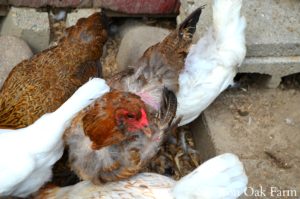 The Molt is coming.
The Molt is coming.
by Jennifer Sartell
In fact for some of you, it might already be here.
August is just around the corner and we’re already seeing signs of the seasonal molt in our flock.
Molt is a healthy, seasonal process for chickens. It usually happens in their second year around late summer to late fall where a chicken will shed out its dirty, damaged feathers and grow nice, new, healthy feathers in time to insulate against the winter cold.
What You’ll See
During molt, you might notice extra feathers on your coop floor and your chickens can end up looking pretty sad. Their feathers may fall out in patches leaving the chicken completely bald in areas, or they might get an overall scruffy look where their plumage is uneven.
Egg Production
 Egg production will come to a screeching halt as the chickens will be utilizing nutrients normally used for egg laying, to instead grow back feathers. Because of this, it is in the egg loving, chicken keeper’s best interest to help your flock overcome molt as quickly as possible.
Egg production will come to a screeching halt as the chickens will be utilizing nutrients normally used for egg laying, to instead grow back feathers. Because of this, it is in the egg loving, chicken keeper’s best interest to help your flock overcome molt as quickly as possible.
Some of the easiest things to do for your flock come in dietary changes. A sprinkling of this, and a handful of that can make all the difference with feather re-growth.
Dietary Changes
Here are 7 dietary changes you can make with your flock to ease the burden of molt.
-
Buy a higher protein feed.
Molt is all about protein, protein, protein. Feathers are made of a protein called keratin. So a feed high in protein will help re-grow feathers quickly. It will also help bulk up your chickens and better prepare them for winter. Try feeding a grower feed (21% protein) meant for meat birds, or mixing in a game bird feed (28% protein) to your normal layer feed. There are also feeds designed for feather re-growth like Nutrena Nature Wise Feather Fixer.
-
Cut out or limit carbohydrate based treats
 Scratch grains, kitchen scraps and corn will dilute your chicken’s intake of protein. For every bite of carbohydrate rich corn, your chicken isn’t filling up on protein. Thus feather production and lack of eggs will last longer.
Scratch grains, kitchen scraps and corn will dilute your chicken’s intake of protein. For every bite of carbohydrate rich corn, your chicken isn’t filling up on protein. Thus feather production and lack of eggs will last longer.
-
Meal worms
A great treat rich in protein is meal worms. Sprinkle a handful of these dehydrated insects to your chickens during molt to encourage feather growth.
-
Feed eggs
Eggs are incredibly healthy for chickens. After all, they provide all the nutrients needed to grow an embryo into a chick. Feeding chickens extra eggs during molt is a great way to nourish your flock.
- Don’t have eggs due to lack of laying because of molt? (kinda a catch 22) Be sure to freeze extra eggs during the more abundant times of the year like spring or early summer, with the purpose of feeding back to your chickens during molt.
- Be sure to cook the eggs by scrambling or hard boiling to disguise the eggs from your chickens. Chicken who are fed raw eggs often recognize that eggs are delicious and they start eating their own eggs right out of the nest boxes. This is a hard habit to break once started.
-
Whey
 Do you also have a dairy cow or goat on your homestead? Feed your chickens the whey after cheese making. They LOVE it and it’s great for feather re-growth.
Do you also have a dairy cow or goat on your homestead? Feed your chickens the whey after cheese making. They LOVE it and it’s great for feather re-growth.
-
Alfalfa
Alfalfa is a legume often found in the form of “hay” bales or in pellets. It’s high in protein and can be offered to chickens in either form in addition to your normal feed.
-
Biotin
Biotin is a B vitamin used for metabolism support and for healthy hair and nails in humans. I take biotin for my own health. I have thyroid problems and one of the symptoms of imbalanced thyroid is hair loss. I take biotin to encourage hair growth.
It works in a similar way for chickens and their feathers. Animal based Biotin supplements are usually found in the “horse” department of the feed store. It’s sold in granular/powder form meant to make horse’s coats shiny and healthy. Sprinkle a handful of biotin powder on your chicken’s feed during molt for healthy feathers.












